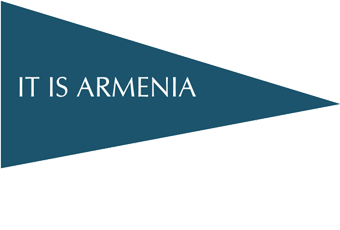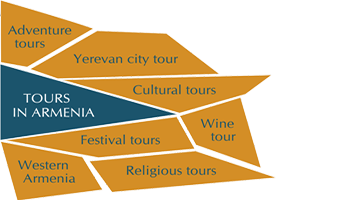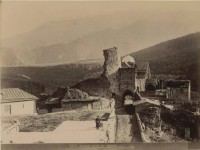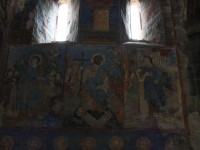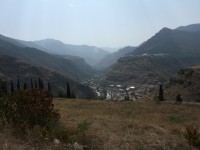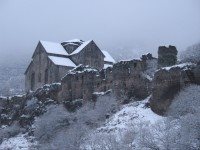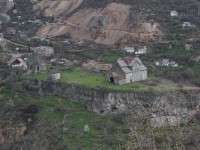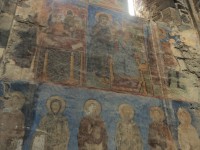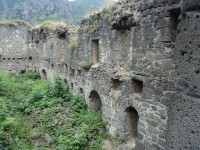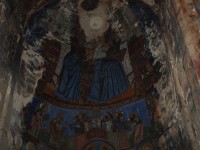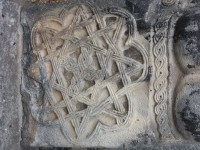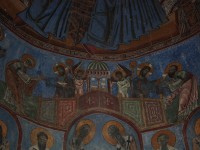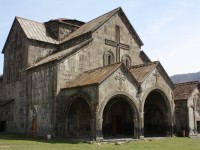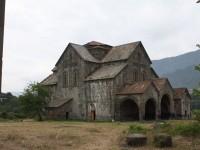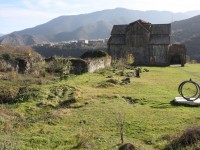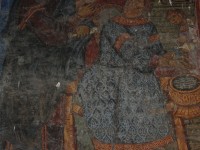Akhtala
Akhtala is a small town, which is located in the Marz (region) of Lori, 191 km far from the city of Yerevan. The city is located 30 km far from the borders between Armenia and Georgia. The interstate road Yerevan-Tbilisi and the railway Yerevan-Tbilisi pass through the territory of Akhtala. The oldest factory of the Caucasus - Mining and Processing Plant is located in Akhtala, which was founded in 1763. According to legend in the second century BC the Armenian King Artashes I Conqueror (Ashkharakal) (189-160 BC) paid a visit to Akhtala and came to the foundry, to look at the works of the masters. One of the masters saw a beautiful ring on the King’s finger, raised a jet of molten copper, and in the air made a ring like the one that the King had. The delighted king presented his ring to the skillful master. Taking into consideration that beautiful legend, in the territory of the church of Akhtala was the world's first wedding rings’ monument of copper was erected a few years ago. Generally, the territory of Akhtala was inhabited by man as far as millenniums ago, which is evidenced by numerous petroglyphs preserved in the territory. The Statue of Liberty in America is made of copper from Akhtala, which the French people presented to the American people, the sculptures of four horses that adorn the facade of St. Mark's Basilica in Venice: these sculptures were presented to the Roman Emperor Nero by the Armenian king Tiridates I (52-88) in the first century. Besides, the residents of Akhtala believe, that the Marshal and French President Charles de Gaulle was their countryman, as in the 1880s, one mining engineer with the same surname was working in Akhtala and the local people are sure that he was the father of the future president of France. Akhtala was also the most multi-ethnic settlement in Armenia: once representatives of 18 nationalities lived there. The copper mine Akhtala was populous settlement in the Middle Ages, what is evidenced by the four fortresses stored in the territory of the city. Together with all this, the visiting card of Akhtala is the Church of the Holy Mother of God (Surb Astvtzatzin). The church of Akhtala was built in 1188 by Mariam; the monastic daughter of Lori’s King Kyurikyan III Kyurike and left the appropriate inscription on the khachkar (cross-stone). The church is built on a high plateau, which has a shape of the peninsula, where is located the Akhtala’s castle, built in the 10th century. The castle was attributed to be built by the king of Lori David I Anhoghin (Lackland). The castle of Akhtala is one of the few castles completely extended in the territory of the Republic of Armenia, with its three-row fences and towers. There is also a single extended building in Armenia In the territory of the castle: the two-storey palace of brothers Ivane and Avag Zakaryans - the only extended royal palace in the territory of Armenia. In the territory of the castle in front of the palace there is also preserved the bath. The walls of the bath are plastered over, the clay and metal pipes are visible Akhtala was the mint of Kyurikyan kings. Here was cut down the only Armenian dram with Armenian letters minted in the territory of Armenia and which belongs to the Lori’s king Kyurike II (1048-1080). Later, after the fall of the Lori’s kingdom, Akhtala became the mint of the Georgian kings Bagratuni. The church of the Holy Mother of God (Surb Astvtzatzin) is a crosswise domed structure with a square build and stands out for its beautiful, stately view. It is a building with a central dome. The outside walls of the church are decorated with huge monumental crosses, which are the largest in the territory of Armenia. The church is special for its frescoes. Here are the biggest in the Armenian monumental fresco fragments: approximately 960 sq. m of the 13th century frescoes, where are pictured different trims of the Old and New Testaments. Among the frescoes one of the few well-preserved images of the Georgian Queen Tamara is preserved. In 1216 in the church of Akhtala was kept the god-pleasing Holy Cross of Noravank that gave rise to endless divisions and disputes. The Holy Trinity Monastery, Arakeloc or the Saint Gevorg’s church are located in the territory of the monastic complex of Akhtala and also two churches of the 13th century are located in the surrounding area of the monastery. In Akhtala is located the marvelous palace built in 1903 by Michael Aramyants, armenian tycoon and benefactor. Several excerpts from the S. Parajanov’s film “The Color of Pomegranate” were shot in Akhtala. It is worth to mention that Akhtala is the only settlement in Armenia where there is no monument to the victims of the Second World War. It is just because a few residents have participated in the war, for the main part of them was working in the mines of Akhtala or in railways. Since 2008 the traditional barbecue festival is held in Akhtala.






